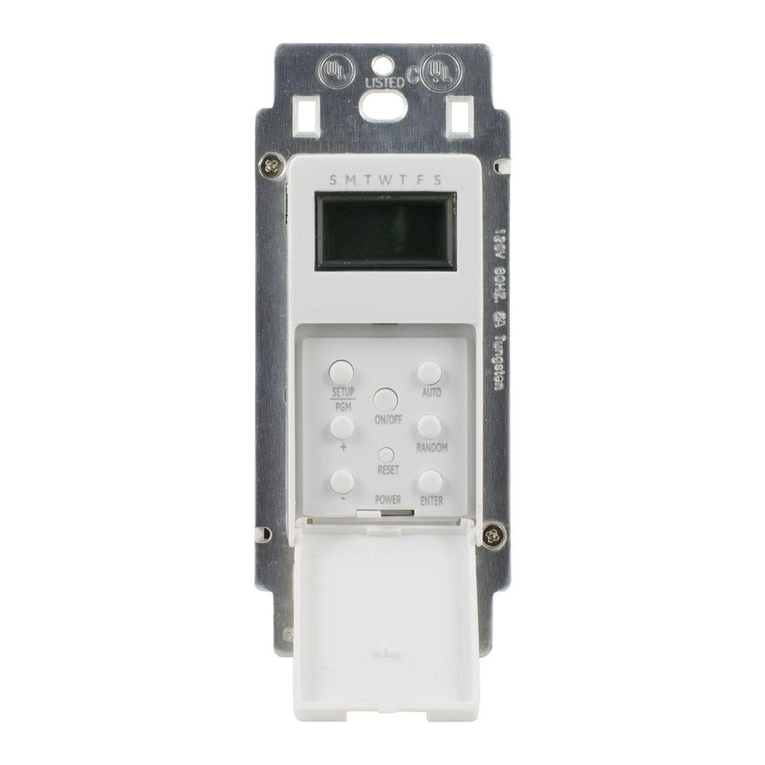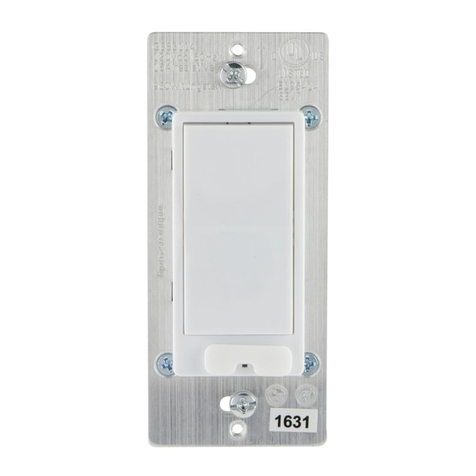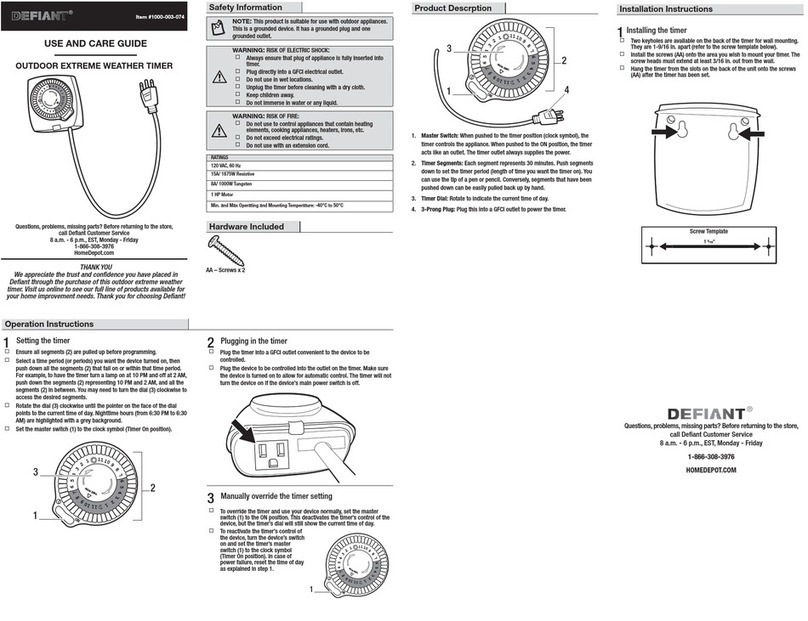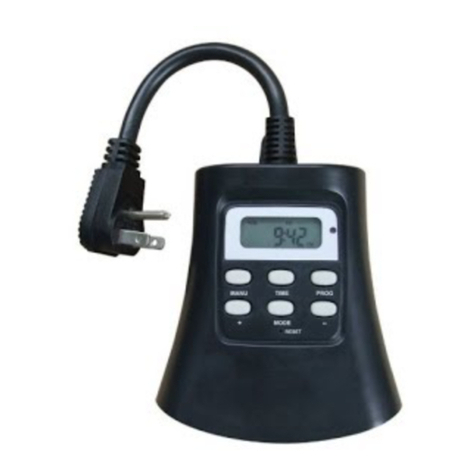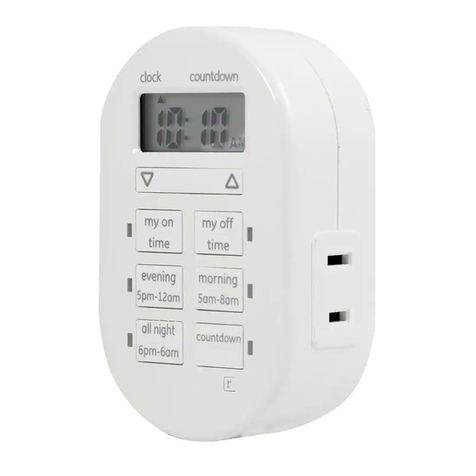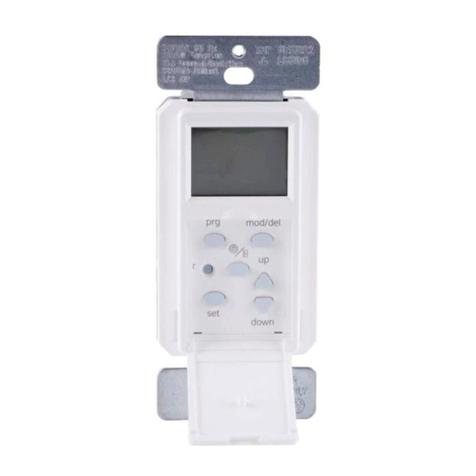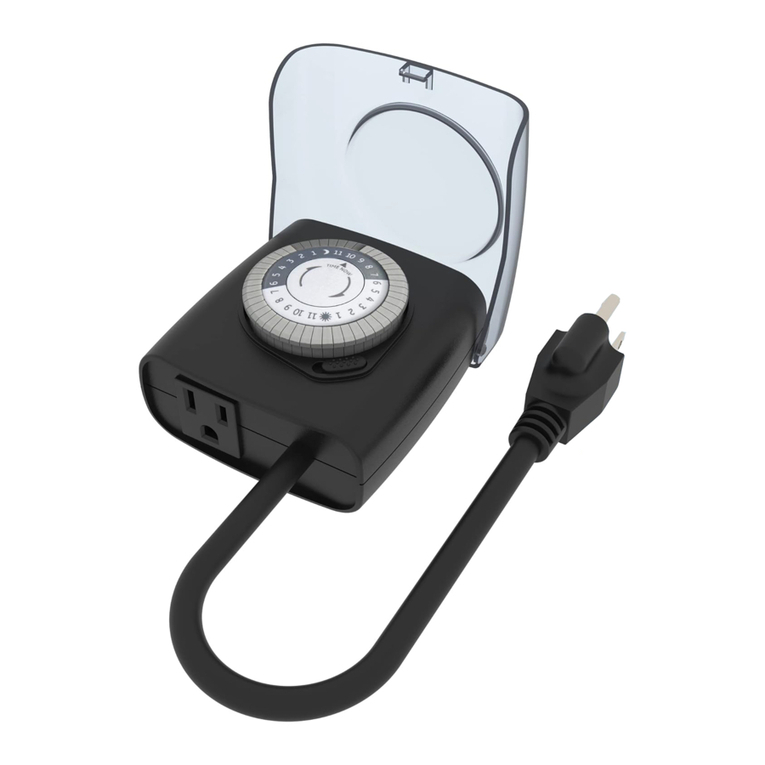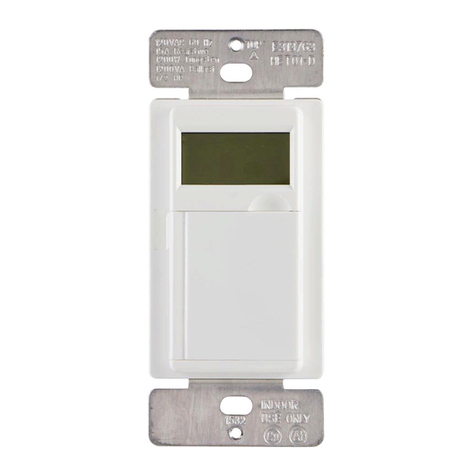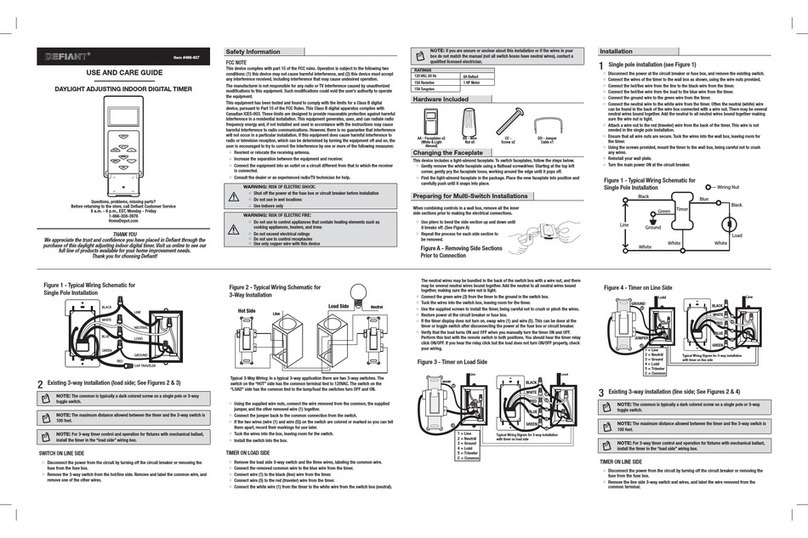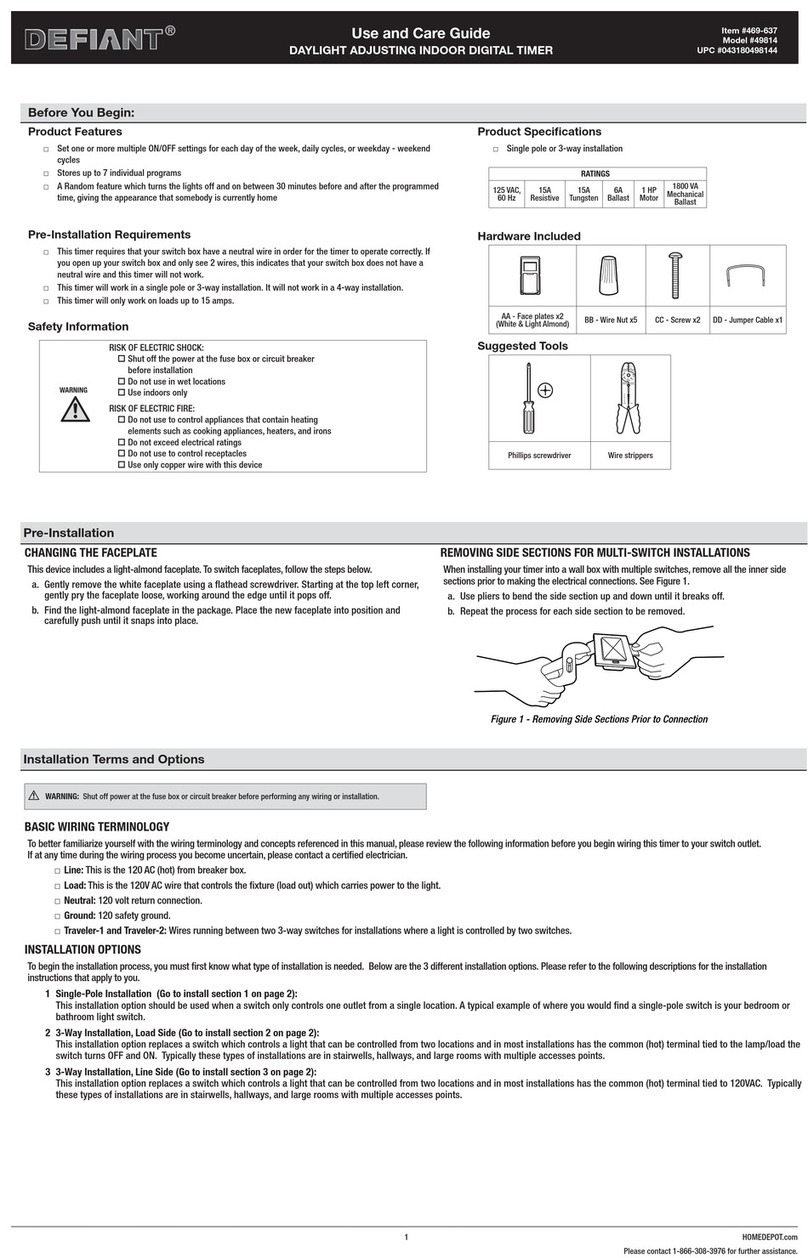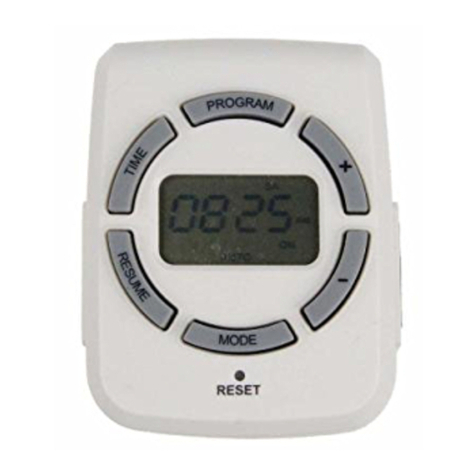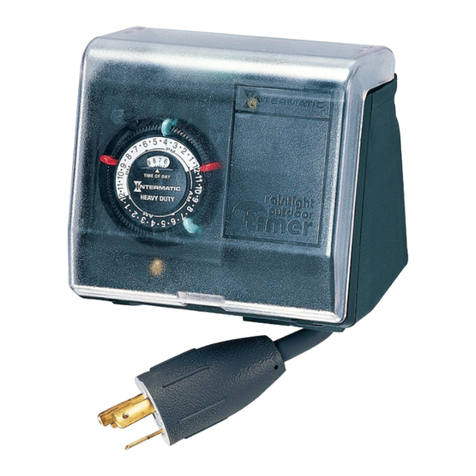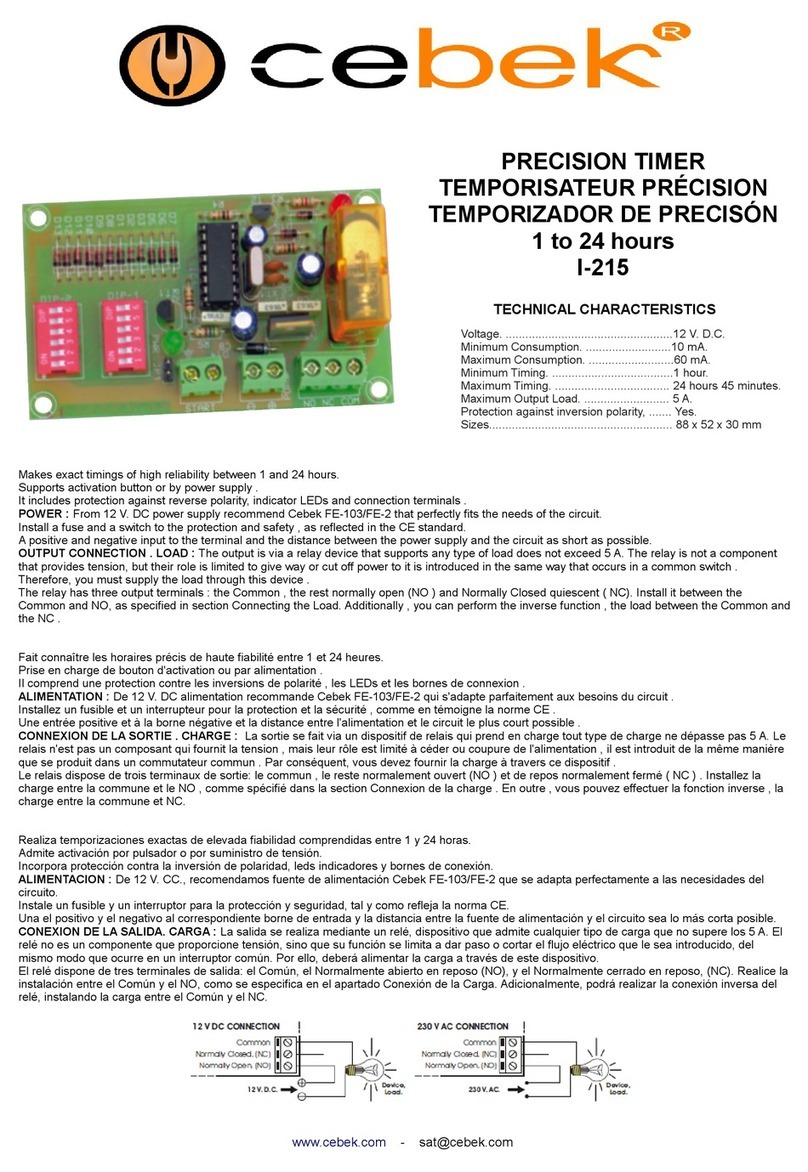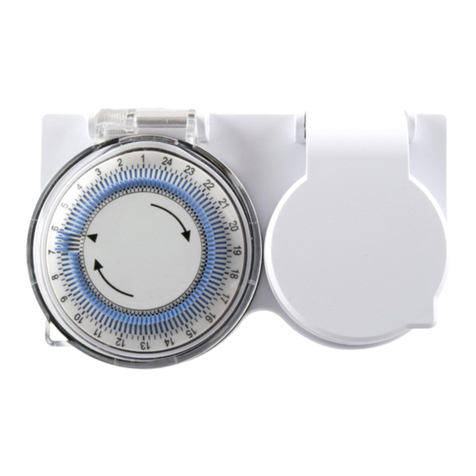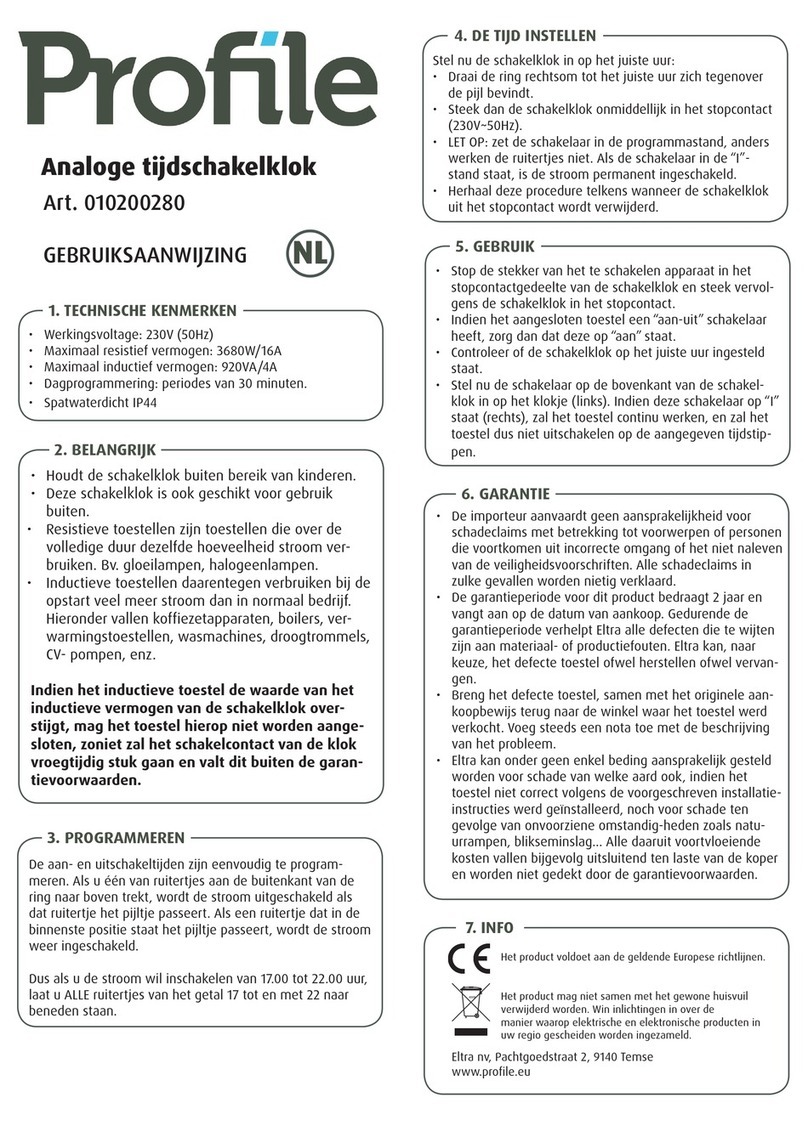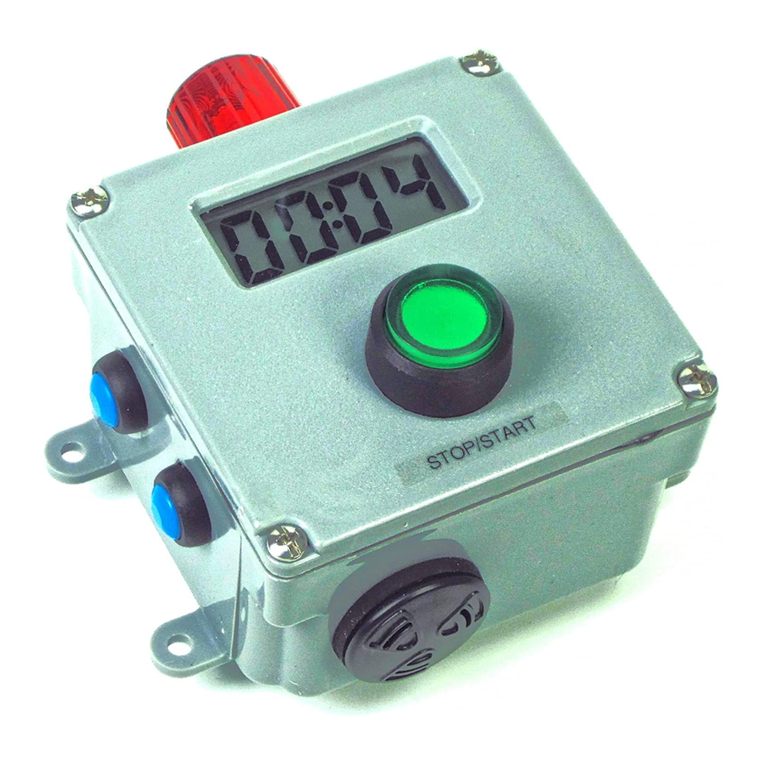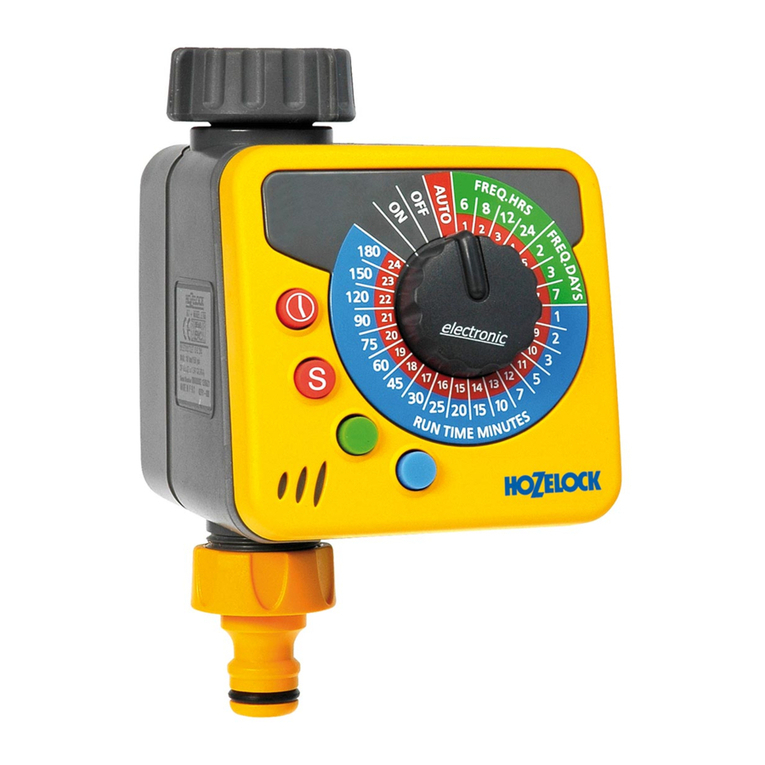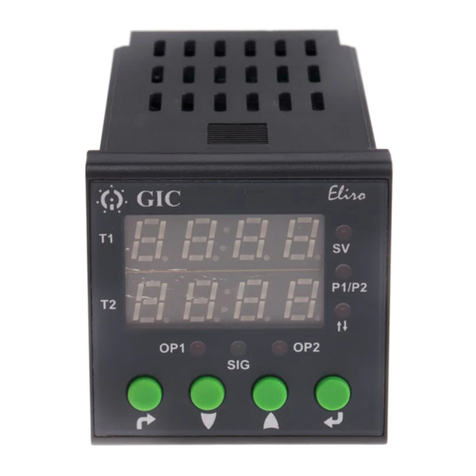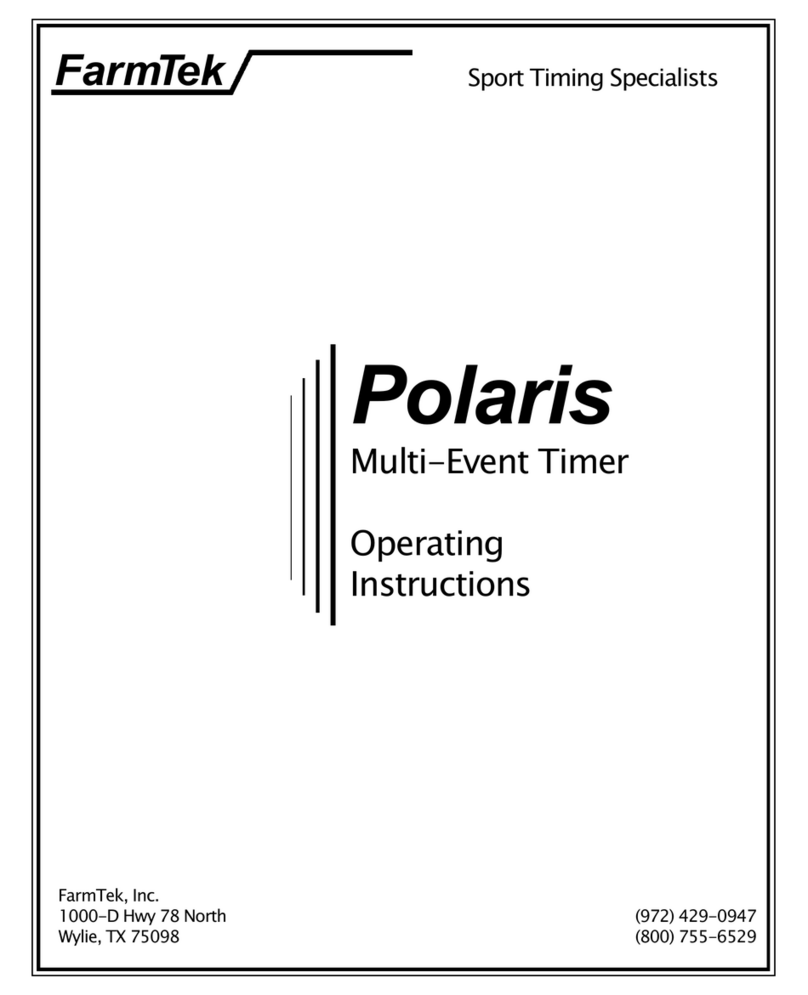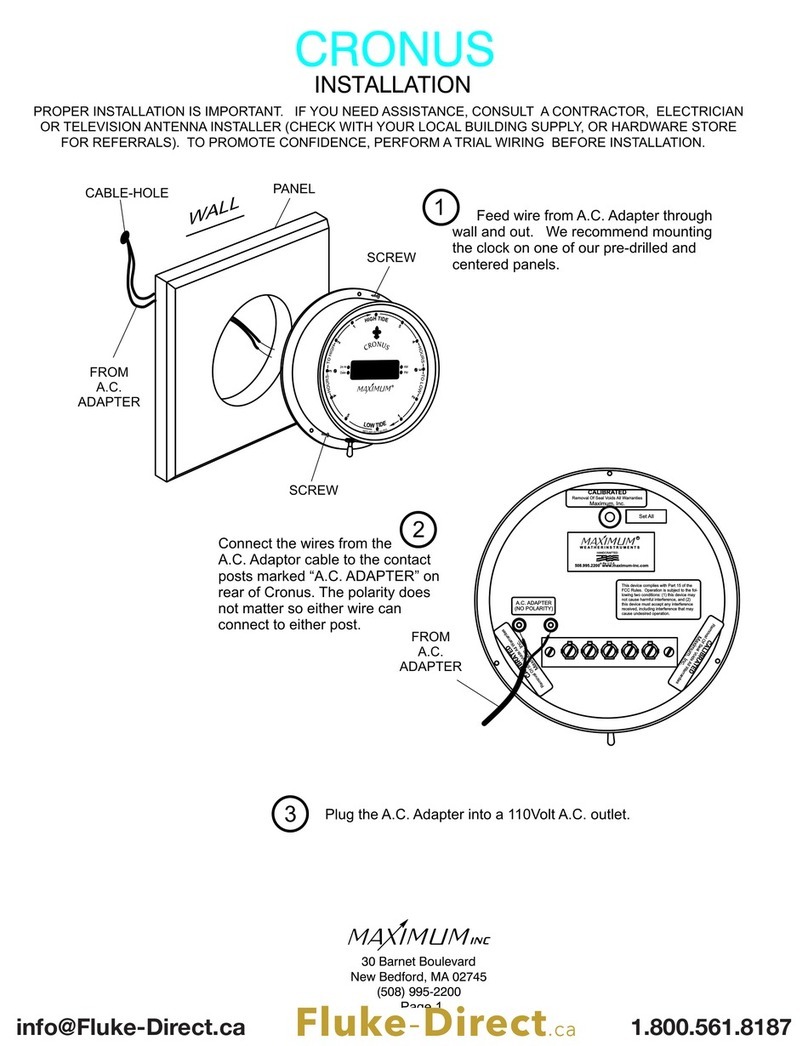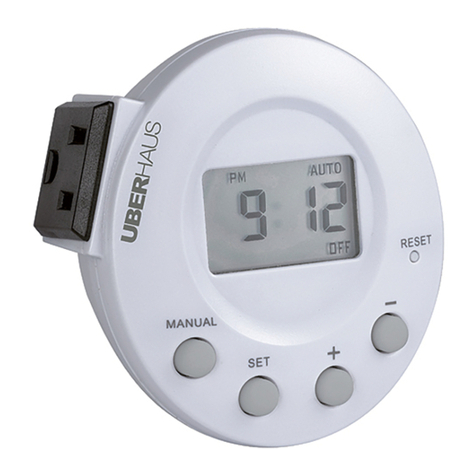IP08292014 HOMEDEPOT.com
Please contact 1-866-308-3976 for further assistance.
Detailed Installation Instructions (continued)
2 EXISTING 3-WAY INSTALLATION (LOAD SIDE; SEE FIGURES 3 & 4)
NOTE: The common is typically a dark colored screw on a single pole or 3-way toggle switch. The maximum distance allowed
between the timer and the 3-way switch is 100 feet.
NOTE: For 3-way timer control and operation for xtures with mechanical ballast, install the timer in the “load side” wiring box.
SWITCH ON LINE SIDE
a. Disconnect the power from the circuit by turning off the circuit breaker or removing the fuse from the fuse box.
b. Remove and label the common wire (should be hot/line), and remove one of the other wires.
c. Using the supplied wire nuts, connect the wire removed from the common, the supplied jumper, and the other removed wire (1) together.
d. Connect the jumper back to the common connection from the switch.
e. If the two wires (wire (1) and wire (5)) on the switch are colored or marked so you can tell them apart, record their markings for use later.
f. Tuck the wires into the box, leaving room for the switch.
g. Install the switch into the box.
TIMER ON LOAD SIDE
a. Remove the load side 3-way switch and the three wires, labeling the common wire.
b. Connect the removed common wire to the blue wire from the timer.
c. Connect wire (1) to the black (line) wire from the timer.
d. Connect wire (5) to the red (traveler) wire from the timer.
e. Connect the white wire (1) from the timer to the white wire from the switch box (neutral).
The neutral wires may be bundled in the back of the switch box with a wire nut, and there may be several neutral wires bound together. Add the neutral to all
neutral wires bound together, making sure the wire nut is tight.
f. Connect the green wire (3) from the timer to the ground in the switch box.
g. Tuck the wires into the switch box, leaving room for the timer.
h. Use the supplied screws to install the timer, being careful not to crush or pinch the wires.
Typical 3-Way Wiring: In a typical 3-way application there are two 3-way switches. The
switch on the “HOT” side has the common terminal tied to 120VAC. The switch on the
“LOAD” side has the common tied to the lamp/load the switches turn OFF and ON.
HH
Hot Side
Load Side Neutral
Line
C
HH
C
3-Way Installation
2
1
5
3
2
5
1
3
4
GREEN
GROUND
WHITE
BLACK
C
Typical Wiring Digram for 3-way installation
with timer on load side
Load
Line
1 = Line
2 = Neutral
3 = Ground
4 = Load
5 = Traveler
C = Common
REDRED
BLUE
BLUE
Figure 4 - Timer on Load Side
i. Restore power at the circuit breaker or fuse box.
j. If the timer display does not turn on, swap wire (1) and wire (5). This can be done at the timer or toggle switch after disconnecting the power at the fuse box or circuit breaker. If the timer display does not turn on, disconnect power at
the circuit breaker or fuse box. Swap wire (1) and wire (5), which can be done at the timer or toggle switch.
k. Verify that the load turns ON and OFF when you manually turn the timer ON and OFF. Perform this test with the remote switch in both positions. You should hear the timer relay click ON/OFF. If you hear the relay click but the load does not turn
ON/OFF properly, check your wiring.
3 EXISTING 3-WAY INSTALLATION (LINE SIDE; SEE FIGURES 3 & 5)
NOTE:The common is typically a dark colored screw on a single pole or 3-way toggle switch. The maximum distance allowed between the timer and
the 3-way switch is 100 feet. For 3-way timer control and operation for xtures with mechanical ballast, install the timer in the “load side” wiring box.
TIMER ON LINE SIDE
a. Disconnect the power from the circuit by turning off the circuit breaker or removing the fuse from the fuse box.
b. Remove the line side 3-way switch and wires, and label the wire removed from the common terminal. Connect the common wire (1) to the black wire
from the timer using the supplied wire nuts.
c. Connect the white wire from the timer to the neutral wire (white). The neutral wires may be bundled together in the back of the box, and there may be
several neutral wires bound together. Add the neutral to all neutral wires bound together, ensuring the wire nut is tight.
d. Connect the two remaining wires to the red wire (5) and blue wire (4) from the timer. The wires are colored or marked, so you can tell them apart and
note their markings for use later.
e. Connect the green wire (3) to the ground wire (green or bare wire in box).
f. Carefully tuck the wires into the switch box, leaving room for the timer.
g. Use the supplied screws to install the timer, being careful not to crush or pinch the wires.
2
4
5
3
2
5
1
3
4
JUMPER
GROUND
Line
Load
C
GREEN
WHITE
BLACK
RED
RED
BLUE
BLUE
Typical Wiring Digram for 3-way installation
with timer on line side
1 = Line
2 = Neutral
3 = Ground
4 = Load
5 = Traveler
C = Common
Figure 5 - Timer on Line Side
SWITCH ON LOAD SIDE
h. Remove the load side 3-way switch and wires, and label the common wire (4).
i. Connect the jumper wire from the switch to both the load wire and wire (4). You should have three wires connected with one wire nut.
j. Connect the jumper back to the common input of the 3-way switch. The other wire (5) should stay connected to one of the other connections of the 3-way switch.
k. Carefully tuck the wires into the switch box leaving room for the timer. Use the screws provided to install the timer in the box, being careful not to crush any wires.
l. Restore power at the circuit breaker or fuse box.
m. Verify that the load turns ON and OFF when you manually turn the timer ON and OFF. Perform this test with the remote switch in both positions.
n. If the load does not operate proprerly, disconnect the power at the circuit breaker or fuse box. Then swap wire (4) and wire (5). This can be done at the time or the toggle switch.
Detailed Operating Instructions
1 SETTING THE TIMER UP FOR THE FIRST TIME
NOTE: This timer will automatically return to the clock mode if a button is not pushed for 60 seconds.
Push the setup button (B) once to return to program mode if this happens.
a. Remove the protective lm from the screen.
b. Using the tip of a pencil, gently press and hold the reset button (D) until you see the word “RESET” scroll
across the screen. Release the button and “12:00 AM” will begin to ash.
c. Press the SETUP button (B) and “CAL” will begin to ash. Press the enter button (G) to begin setting the
calendar, and the year will begin to ash (Figure 5B).
d. Press the “+” or “-” button (C) to set the current year. Press the enter button (G), and the month will begin to
ash.
e. Repeat the sequence in step d. to set the current month, day, hour,
and minute, pressing the enter button (G) to continue to the next step.
f. Press the “+” or “-” button (C) to turn Daylight Savings time ON/OFF. Press the enter (G) button to conrm
conrm.
NOTE: Choose DST ON if your local area observes Daylight Savings time. The timer will automatically
adjust backwards and forwards an hour. Choose DST OFF if your local area does not observe Daylight
Savings time.
2 SETTING THE TIME ZONE
View the map below and determine which zone best ts your location. The options are NOR: North, CENT: Central, SOUT:
South, HAWA: Hawaii, and ALAS: Alaska.
a. “ZONE” will be ashing on your screen. Press the enter button (G) to begin setting your time zone, and “NOR” will
begin to ash. Use the “+” or “-” button (C) to select the zone identied. Press the enter button (G) to conrm, and
“DAWN” will be displayed with an approximate dawn time for your area.
b. Press the “+” or “-” button (C) to set your current dawn hour. Press the enter button (G) to conrm.
c. Press the “+” or “-” button (C) to set your current dawn minute. Press the enter button (G) to conrm, and “DUSK”
will be displayed.
d. Use the same process to set the dusk hour and minute, and “SAVE” will be displayed.
e. Press the enter button (G) to save the current date and time information.
ALASKA
HAWAII
NORTH NORTH
CENTRAL
CENTRAL
SOUTH SOUTH
Setting the time zone
3 PROGRAMMING THE ON/OFF DAYS
a. Press the setup button (B) twice to begin programming ON/OFF days, and “P1 ON” will display.
b. Press the enter button (G) once, and “SET” will display. Press the enter button (G) again to begin setting the ON
time, and “PRG” will be displayed with the days of the week ashing.
c. Press the “+” or “-” button (C) to select the day(s) you want this program to turn the timer ON:
□S, S (Saturday and Sunday)
□M, T, W, Th, F (weekdays only)
□S, M, T, W, Th, F, S (individual days)
□T, Th (Tuesday and Thursday)
□M, W, F (Monday, Wednesday, and Friday)
□S, M, T, W, Th, F, S (default: all days of the week)
d. Press the enter button (G) to conrm the setting.
4 PROGRAMMING THE ON/OFF TIME
There are three options to choose from when selecting the program ON time. Press the “+” or “-” button (C) to scroll through
these options:
DAWN
TIME (for custom times) Complete the steps in this section to program the custom TIME option you have chosen.
DUSK
a. Press the enter button (D) to conrm the desired setting. If you have selected TIME, the hour will begin to ash.
b. Press the “+” or “-” button (C) to set the hour you want the timer to turn ON. Press the enter button (G) when the
hour and AM/PM are correct, and the minute will begin to ash.
c. Press the “+” or “-” button (C) to select the minute you want the timer to turn ON. Press the enter button (G), and
“P1 OFF” and “PRG” will be displayed. Follow the previous steps to set the OFF days and times.
d. Once nished, “Save” will begin ashing. Press the enter button (G) to save this program, and “P2 ON” will be
displayed, with P2 ashing. If you need additional programs, press the enter button (G) and repeat the steps
above to set the next program ON/OFF times. When you are nished, press the auto button (E) to complete the
programming.
5 USING THE MANUAL OVERRIDE ON/OFF
This timer has a manual override ON/OFF that will override your programmed time settings to turn your light ON and OFF.
While in this manual mode, your timer will work like a normal light switch.
a. Press and hold the “+” and “-” Buttons (C) at the same time until you see MAN display on the screen.
b. Now your timer will work like a manual switch, just press on the timer door to activate it for ON/OFF.
To return to your AUTO timer mode (where your timer programs will work again), press the AUTO Button (E)
6 USING THE RANDOM FEATURE
The random feature will turn the lights ON and OFF using the programmed times “+” or “-” 30 minutes, giving the house a
more lived-in appearance while the occupant is away.
a. Push the RND button (F) to activate the random feature. The screen will change from AUTO to RDM.
b. Push the auto button (E) to de-activate the random feature and return the timer to its current programming.
7 REVIEWING PREVIOUSLY ENTERED PROGRAMS
a. Press the setup button (B) twice, then press the “+” or “-” button (C) to scroll through the previously entered
programs.
b. Press the auto button (E) when you are done reviewing.
8 DELETING PREVIOUSLY ENTERED PROGRAMS
Press the setup button (B) twice, then press the “+” or “-” button (C) to scroll to the program you wish to delete. Press the
enter button (G) and “SET” will display.
a. Press the “+” or “-” button (C) until the screen reads “DEL,” then press the enter button (G).
b. The program is now deleted, and you may press the “+” or “-” button (C) to select another program for deletion
following the steps above. Press the auto button (E) when you have completed deleting all desired programs.
